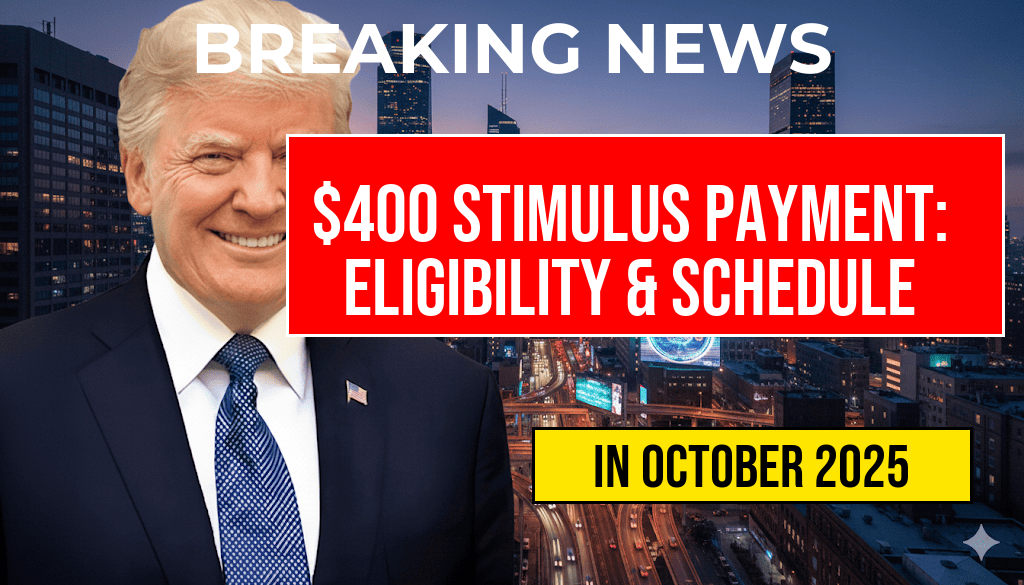The federal government has announced a new initiative offering a $400 stimulus payment for all eligible Americans, aiming to provide economic relief amid ongoing financial challenges. This one-time payment is designed to reach millions of qualifying individuals across the country, with specific eligibility requirements and a structured payment schedule. The program, which is part of broader efforts to support households during turbulent economic conditions, is scheduled to roll out in phases over the coming months. Eligible recipients can expect to receive their payments via direct deposit or paper check, depending on their registration preferences and existing banking information. Authorities emphasize that the program aims to be inclusive, targeting a wide demographic while ensuring that those most in need receive timely assistance.
Understanding Eligibility Requirements
Who Qualifies for the $400 Stimulus Payment?
The stimulus initiative primarily targets individual taxpayers, families, and vulnerable populations to ensure broad coverage. Specific eligibility criteria include:
- Income Limits: Individuals earning up to $75,000 annually and families with combined incomes up to $150,000 qualify for the full payment. Those with incomes above these thresholds may receive reduced amounts based on income phase-out calculations.
- Filing Status: The program is open to taxpayers who filed a 2022 or 2023 tax return, including single filers, married couples filing jointly, and heads of household.
- Residency Requirements: Applicants must be U.S. residents or citizens, with valid Social Security numbers, and have a primary residence within the United States.
- No Criminal Record Restrictions: The program does not exclude individuals with criminal records unless otherwise specified.
Additional Considerations
Recipients must ensure their latest contact information and banking details are up-to-date to facilitate seamless payments. The IRS has urged taxpayers to verify their details through their official portal to avoid delays. Certain groups, such as dependents and non-citizens, are not eligible for this specific payment, though they may qualify for other assistance programs.
Complete Payment Schedule and Distribution Method
Payment Timeline
| Phase | Start Date | End Date | Description |
|---|---|---|---|
| Initial Disbursement | March 15, 2024 | March 31, 2024 | Payments for early filers and direct deposit recipients |
| Secondary Round | April 10, 2024 | April 30, 2024 | Payments for those who filed later or used paper checks |
| Final Phase | May 15, 2024 | May 31, 2024 | Remaining payments and corrections |
Distribution Methods
Recipients can expect their $400 stimulus payments via two primary channels:
- Direct Deposit: If taxpayers have provided banking information through their tax filings or the IRS portal, payments will be automatically deposited.
- Paper Checks: For those without direct deposit details, physical checks will be mailed to the address registered with the IRS.
The IRS has increased efforts to promote online registration and update of banking information to expedite distribution, with an emphasis on reducing delays caused by outdated contact details.
Additional Resources and Support
Taxpayers seeking further information about eligibility, payment status, or how to update their banking details can visit the IRS official website at irs.gov. For general updates on federal economic relief programs, reputable outlets like Forbes provide ongoing coverage and analysis.
In cases of discrepancies or delays, individuals are encouraged to contact the IRS directly or consult with a tax professional to ensure their information is accurate and complete. The government underscores its commitment to ensuring that the $400 stimulus payment reaches as many eligible Americans as possible in a timely manner, providing essential financial support amid ongoing economic uncertainties.
Frequently Asked Questions
What are the eligibility requirements for the $400 stimulus payment?
To qualify for the $400 stimulus payment, individuals must meet specific income thresholds, have valid social security numbers, and file a 2023 tax return if required. Additionally, certain public assistance recipients may be eligible.
How and when will the $400 stimulus payments be distributed?
The payment schedule indicates that eligible recipients will receive their stimulus payments via direct deposit or check starting from October 2023. The full distribution process is expected to be completed within 6 weeks.
Are dependents eligible for the $400 stimulus payment?
No, dependents are not eligible for the $400 stimulus payment unless they meet specific eligibility criteria. The payment primarily goes to individuals who meet the income and filing requirements.
What should I do if I haven’t received my stimulus payment by the expected date?
If you haven’t received your $400 stimulus payment by the expected date, you should check your payment status through the official IRS portal or contact customer support for assistance. Delays may occur due to processing issues.
Can I receive the $400 stimulus payment if I file as self-employed or have unusual income?
Yes, self-employed individuals and those with unusual income can qualify if they meet the eligibility requirements and properly file their tax returns. Ensure all income is accurately reported to determine eligibility.

Leave a Reply